| Listing 1 - 10 of 23 | << page >> |
Sort by
|
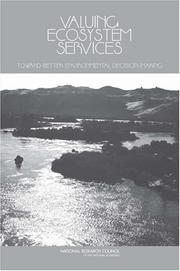
ISBN: 030909318X 9786610175840 1280175842 0309545862 9780309545860 9780309093187 0309133459 9780309133456 9781280175848 6610175845 Year: 2005 Publisher: Washington, D.C. National Academies Press
Abstract | Keywords | Export | Availability | Bookmark
 Loading...
Loading...Choose an application
- Reference Manager
- EndNote
- RefWorks (Direct export to RefWorks)
Aquatic ecology --- Biotic communities --- Environmental policy --- Environmental protection --- Economic aspects. --- Decision making. --- Biocenoses --- Biocoenoses --- Biogeoecology --- Biological communities --- Biomes --- Biotic community ecology --- Communities, Biotic --- Community ecology, Biotic --- Ecological communities --- Ecosystems --- Natural communities --- Ecology --- Population biology --- Aquatic biology
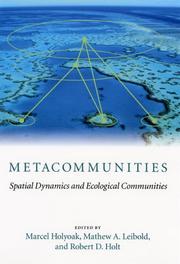
ISBN: 0226350630 0226350649 9780226350646 Year: 2005 Publisher: Chicago University of Chicago Press
Abstract | Keywords | Export | Availability | Bookmark
 Loading...
Loading...Choose an application
- Reference Manager
- EndNote
- RefWorks (Direct export to RefWorks)
Until recently community ecology& a science devoted to understanding the patterns and processes of species distribution and abundance& focused mainly on specific and often limited scales of a single community. Since the 1970s, for example, metapopulation dynamics& studies of interacting groups of populations connected through movement& concentrated on the processes of population turnover, extinction, and establishment of new populations. 'Metacommunities' takes the hallmarks of metapopulation theory to the next level by considering a group of communities, each of which may contain numerous populations, connected by species interactions within communities and the movement of individuals between communities. In examining communities open to dispersal, the book unites a broad range of ecological theories, presenting some of the first empirical investigations and revealing the value of the metacommunity approach. The collection of empirical, theoretical, and synthetic chapters in 'Metacommunities' seeks to understand how communities work in fragmented landscapes. Encouraging community ecologists to rethink some of the leading theories of population and community dynamics, 'Metacommunities' urges ecologists to expand the spatiotemporal scales of their research.
574 --- General ecology. Biocoenology. Hydrobiology. Biogeography --- Biogeography. --- Biotic communities. --- Population biology. --- Spatial ecology. --- 574 General ecology. Biocoenology. Hydrobiology. Biogeography --- Biogeography --- Biotic communities --- Population biology --- Spatial ecology --- Areography (Biology) --- Geographical distribution of animals and plants --- Species --- Species distribution --- Biology --- Geography --- Ecology --- Biocenoses --- Biocoenoses --- Biogeoecology --- Biological communities --- Biomes --- Biotic community ecology --- Communities, Biotic --- Community ecology, Biotic --- Ecological communities --- Ecosystems --- Natural communities --- Geographical distribution
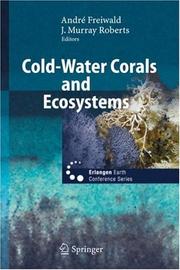
ISBN: 1280412283 9786610412280 3540276734 3540241361 Year: 2005 Publisher: Berlin : Springer-Verlag,
Abstract | Keywords | Export | Availability | Bookmark
 Loading...
Loading...Choose an application
- Reference Manager
- EndNote
- RefWorks (Direct export to RefWorks)
Following the exciting exploration of hot vent and cold seep ecosystems, the rediscovery of cold-water coral ecosystems with high-technology instrumentation is currently another hot topic in multidisciplinary marine research. Conventionally, coral reefs are regarded as restricted to warm and well-illuminated tropical seas, not associated with cold and dark waters of higher latitudes. However, ongoing scientific missions have shed light on the global significance of this overlooked ecosystem. Cold-water coral ecosystems are involved in the formation of large seabed structures such as reefs and giant carbonate mounds, and they represent unexploited paleo-environmental archives of earth history. Like their tropical cousins, cold-water coral ecosystems harbour rich species diversity. Despite the great water depths, commercial interests overlap more and more with the coral occurrences. Human activities already impinge directly on cold-water coral reefs causing severe damage to this vulnerable ecosystem. In this volume, the current key institutions involved in cold-water coral research have contributed 62 state-of-the-art articles from geology and oceanography to biology and conservation.
Corals --- Deep-sea ecology --- Coral reef ecology --- Coral reefs and islands --- Reef ecology --- Marine ecology --- Lithophytes --- Anthozoa --- Ecology --- Oceanography. --- Paleontology . --- Sedimentology. --- Endangered ecosystems. --- Biogeosciences. --- Paleontology. --- Ecosystems. --- Threatened ecosystems --- Biotic communities --- Nature conservation --- Petrology --- Fossilogy --- Fossilology --- Palaeontology --- Paleontology, Zoological --- Paleozoology --- Historical geology --- Zoology --- Fossils --- Prehistoric animals in motion pictures --- Oceanography, Physical --- Oceanology --- Physical oceanography --- Thalassography --- Earth sciences --- Marine sciences --- Ocean --- Geobiology. --- Biocenoses --- Biocoenoses --- Biogeoecology --- Biological communities --- Biomes --- Biotic community ecology --- Communities, Biotic --- Community ecology, Biotic --- Ecological communities --- Ecosystems --- Natural communities --- Population biology --- Biology --- Biosphere
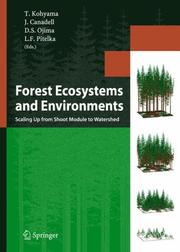
ISBN: 1281242845 9786611242848 4431293612 4431260749 4431998101 Year: 2005 Publisher: Tokyo : Springer-Verlag,
Abstract | Keywords | Export | Availability | Bookmark
 Loading...
Loading...Choose an application
- Reference Manager
- EndNote
- RefWorks (Direct export to RefWorks)
Coastal East and Southeast Asia are characterized by wet growing seasons, and species-rich forest ecosystems develop throughout the latitudinal and altitudinal gradients. In this region, the Global Change Impacts on Terrestrial Ecosystems in Monsoon Asia (TEMA) project was carried out as a unique contribution to the international project Global Change and Terrestrial Ecosystems. TEMA aimed to integrate forest ecosystem processes, from leaf physiology to meteorological budget and prediction of long-term change of vegetation composition and architecture through demographic processes. Special attention was given to watershed processes, where forest ecosystem metabolism affects the properties and biogeochemical budgets of freshwater ecosystems, and where rivers, wetlands, and lakes are subject to direct and indirect effects of environmental change. This volume presents the scaling-up concept for better understanding of ecosystem functioning.
Forest ecology. --- Forest ecology --- Forests and forestry --- Ecology --- Ecology. --- Plant Ecology. --- Endangered ecosystems. --- Ecosystems. --- Biogeosciences. --- Threatened ecosystems --- Biotic communities --- Nature conservation --- Botany --- Plants --- Balance of nature --- Biology --- Bionomics --- Ecological processes --- Ecological science --- Ecological sciences --- Environment --- Environmental biology --- Oecology --- Environmental sciences --- Population biology --- Phytoecology --- Vegetation ecology --- Ecology . --- Plant ecology. --- Geobiology. --- Earth sciences --- Biosphere --- Biocenoses --- Biocoenoses --- Biogeoecology --- Biological communities --- Biomes --- Biotic community ecology --- Communities, Biotic --- Community ecology, Biotic --- Ecological communities --- Ecosystems --- Natural communities --- Floristic ecology
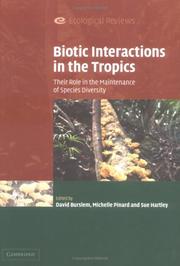
ISBN: 0521847079 0521609852 9780521609852 9780521847070 9780511541971 051154197X 9780511128011 0511128010 0511127480 9780511127489 1107152607 1280434902 9786610434909 051120017X 0511182538 0511300603 Year: 2005 Publisher: Cambridge Cambridge University Press
Abstract | Keywords | Export | Availability | Bookmark
 Loading...
Loading...Choose an application
- Reference Manager
- EndNote
- RefWorks (Direct export to RefWorks)
Tropical ecosystems house a significant proportion of global biodiversity. To understand how these ecosystems function we need to appreciate not only what plants, animals and microbes they contain, but also how they interact with each other. This volume, first published in 2005, synthesises the state of knowledge in this area, with chapters providing reviews or case studies drawn from research conducted in both Old and New World tropics and including biotic interactions among taxa at all trophic levels. In most chapters plants (typically trees) are the starting point, but, taken together, the chapters consider interactions of plants with other plants, with micro-organisms and with animals, and the inter-relationships of human-induced disturbance with interactions among species. An underlying theme of the volume is the attempt to understand the maintenance of high diversity in tropical regions, which remains one of the most significant unexplained observations in ecological studies.
Ecology --- Biotic communities --- Species diversity --- Ecologie --- Ecosystèmes --- Diversité des espèces --- ECO Ecology --- biodiversity --- ecology --- plant-animal relationships --- tropical forests --- tropical regions --- 574.4 --- Terrestrial biocoenoses and ecosystems. Biogeocoenoses. Biogeochemical cycles. Food chains --- 574.4 Terrestrial biocoenoses and ecosystems. Biogeocoenoses. Biogeochemical cycles. Food chains --- Ecosystèmes --- Diversité des espèces --- Diversity, Species --- Richness, Species --- Species richness --- Biodiversity --- Biocenoses --- Biocoenoses --- Biogeoecology --- Biological communities --- Biomes --- Biotic community ecology --- Communities, Biotic --- Community ecology, Biotic --- Ecological communities --- Ecosystems --- Natural communities --- Population biology
Book
ISBN: 1281103217 9786611103217 1402034660 Year: 2005 Publisher: Dordrecht ; New York : Springer,
Abstract | Keywords | Export | Availability | Bookmark
 Loading...
Loading...Choose an application
- Reference Manager
- EndNote
- RefWorks (Direct export to RefWorks)
Decomposition of organic matter is a major ecosystem process involving an array of different organisms, including bacteria, fungi and invertebrates. The main objective of this book is to provide students and laboratory instructors at universities and professional ecologists with a broad range of established methods to study plant litter decomposition. Detailed protocols for direct use in the field or laboratory are presented in an easy to follow step-by-step format. A short introduction to each protocol reviews the ecological significance and principles of the technique and points to key references. Although most methods are described for freshwater ecosystems, many will work equally well in the presented or slightly modified form for studies in marine and terrestrial environments.
Plant litter --- Plant ecology. --- Botany --- Plants --- Ecology --- Biodegradation. --- Biodegradation --- Ecology. --- Plant Ecology. --- Sedimentology. --- Endangered ecosystems. --- Microbial ecology. --- Microbiology. --- Ecosystems. --- Microbial Ecology. --- Microbial biology --- Biology --- Microorganisms --- Environmental microbiology --- Microbiology --- Threatened ecosystems --- Biotic communities --- Nature conservation --- Petrology --- Balance of nature --- Bionomics --- Ecological processes --- Ecological science --- Ecological sciences --- Environment --- Environmental biology --- Oecology --- Environmental sciences --- Population biology --- Ecology . --- Biocenoses --- Biocoenoses --- Biogeoecology --- Biological communities --- Biomes --- Biotic community ecology --- Communities, Biotic --- Community ecology, Biotic --- Ecological communities --- Ecosystems --- Natural communities --- Phytoecology --- Vegetation ecology --- Floristic ecology
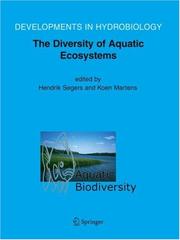
ISBN: 9781402037450 9781402041112 1402037457 1402029519 9786611067403 1281067407 140204111X 904816754X 9786610312153 1280312157 1402032404 9781402029516 Year: 2005 Volume: 180 Publisher: Dordrecht : Springer,
Abstract | Keywords | Export | Availability | Bookmark
 Loading...
Loading...Choose an application
- Reference Manager
- EndNote
- RefWorks (Direct export to RefWorks)
Freshwater Biodiversity is a much underestimated component of global biodiversity, both in its diversity and in its potential to act as models for fundamental research in evolutionary biology and ecosystem studies. Freshwater organisms also reflect quality of water bodies and can thus be used to monitor changes in ecosystem health. The present book comprises a unique collection of primary research papers spanning a wide range of topics in aquatic biodiversity studies, and including a first global assessment of specific diversity of freshwater animals. The book also presents a section on the interaction between scientists and science policy managers. A target opinion paper lists priorities in aquatic biodiversity research for the next decade and several reactions from distinguished scientists discuss the relevance of these items from different points of view: fundamental ecology, taxonomy and systematics, needs of developing countries, present-day biodiversity policy at European and at global scales. It is believed that such a platform for the interaction between science and science policy is an absolute necessity for the efficient use of research budgets in the future.
Aquatic biology --- Biodiversity --- Endangered ecosystems --- Freshwater biodiversity. --- Life sciences. --- Biodiversity. --- Ecosystems. --- Aquatic ecology. --- Life Sciences. --- Life Sciences, general. --- Freshwater & Marine Ecology. --- Fresh-water biology --- Freshwater ecology --- Ecology --- Biocenoses --- Biocoenoses --- Biogeoecology --- Biological communities --- Biomes --- Biotic community ecology --- Communities, Biotic --- Community ecology, Biotic --- Ecological communities --- Ecosystems --- Natural communities --- Population biology --- Biological diversification --- Biological diversity --- Biotic diversity --- Diversification, Biological --- Diversity, Biological --- Biology --- Biocomplexity --- Ecological heterogeneity --- Numbers of species --- Biosciences --- Sciences, Life --- Science --- Marine biodiversity. --- Aquatic biodiversity.
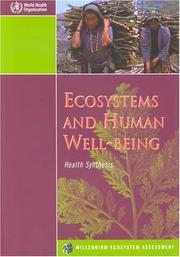
ISBN: 9241563095 9786610436286 128043628X 9240680284 Year: 2005 Publisher: Geneva World health organization
Abstract | Keywords | Export | Availability | Bookmark
 Loading...
Loading...Choose an application
- Reference Manager
- EndNote
- RefWorks (Direct export to RefWorks)
This report synthesizes the findings from the Millennium Ecosystem Assessment (MA) global and sub-global assessments of how ecosystem changes do, or could, affect human health and well-being. Over the past 50 years humans have changed natural ecosystems more rapidly and extensively than any comparable period in human history. The findings provide the strongest evidence so far of the ways in which pressures on ecosystems have resulted in the loss of vital ecosystem services, which purify and replenish water, soil and air resources essential to health, and also keep many diseases in check. Loss
Biotic communities --- Environmental health --- Environmental risk assessment --- Sustainable development --- Development, Sustainable --- Ecologically sustainable development --- Economic development, Sustainable --- Economic sustainability --- ESD (Ecologically sustainable development) --- Smart growth --- Sustainable economic development --- Economic development --- Risk assessment --- Precautionary principle --- Environmental quality --- Health --- Health ecology --- Public health --- Environmental engineering --- Health risk assessment --- Health aspects --- Environmental aspects --- Environmental health. --- Biotic communities. --- Biocenoses --- Biocoenoses --- Biogeoecology --- Biological communities --- Biomes --- Biotic community ecology --- Communities, Biotic --- Community ecology, Biotic --- Ecological communities --- Ecosystems --- Natural communities --- Ecology --- Population biology
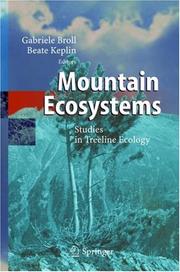
ISBN: 1280412917 9786610412914 3540273654 3540243259 3642063608 Year: 2005 Publisher: Berlin ; New York : Springer,
Abstract | Keywords | Export | Availability | Bookmark
 Loading...
Loading...Choose an application
- Reference Manager
- EndNote
- RefWorks (Direct export to RefWorks)
Mountain ecosystems belong to the most endangered ecosystems in the world. Especially, the treeline ecotone acts as an indicator for environmental change. However, ecological processes in the treeline ecotone are not yet completely understood. The studies provided in this book may contribute to a better understanding of the interactions between vegetation, climate, fauna, and soils in the treeline ecotone. An introductory chapter is given on plants living under extreme conditions, climate change aspects, and methods for characterization of alpine soils. The following articles focus on mountainous areas in America, Europe and Asia. The Working Group on Mountain and Northern Ecosystems at the Insti- te of Landscape Ecology, University of Münster (Germany), has been working on topics related to the treeline ecotone for several decades. This period under the chairmanship of Friedrich-Karl Holtmeier has come to an end now when he retired in 2004. He initiated numerous studies in high mountains and in the North. Many of his students, who became infected by the ‘mountain virus’, will continue these investigations on ecological processes in the altitudinal and northern treeline ecotones. With this compilation of studies in mountain ecosystems we want to thank Friedrich-Karl Holtmeier for his excellent guidance in these cold and fascinating environments.
Mountain ecology. --- Timberline. --- Alpine timberline --- Alpine treeline --- Latitudinal timberline --- Latitudinal treeline --- Timber-line --- Tree line --- Treeline --- Forest ecology --- Mountain ecology --- Vegetation boundaries --- Alpine ecology --- Alpine region ecology --- Alpine regions --- Mountains --- Upland ecology --- Ecology --- Geology. --- Ecology. --- Endangered ecosystems. --- Geography. --- Biogeosciences. --- Geoecology/Natural Processes. --- Ecosystems. --- Geography, general. --- Cosmography --- Earth sciences --- World history --- Threatened ecosystems --- Biotic communities --- Nature conservation --- Balance of nature --- Biology --- Bionomics --- Ecological processes --- Ecological science --- Ecological sciences --- Environment --- Environmental biology --- Oecology --- Environmental sciences --- Population biology --- Geognosy --- Geoscience --- Natural history --- Geobiology. --- Ecology . --- Geoecology. --- Environmental geology. --- Biocenoses --- Biocoenoses --- Biogeoecology --- Biological communities --- Biomes --- Biotic community ecology --- Communities, Biotic --- Community ecology, Biotic --- Ecological communities --- Ecosystems --- Natural communities --- Geoecology --- Environmental protection --- Physical geology --- Biosphere
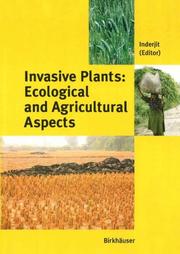
ISBN: 1280413158 9786610413157 3764373806 3764371374 Year: 2005 Publisher: Basel ; Boston : Birkhauser,
Abstract | Keywords | Export | Availability | Bookmark
 Loading...
Loading...Choose an application
- Reference Manager
- EndNote
- RefWorks (Direct export to RefWorks)
The study of plant invasions is the science that attempts to understand causes and consequences of plant introductions outside of their native areas. Invasive plants have an impact on global biodiversity and ecosystem function, and their management is a complex and formidable task. The applied aspects of this study include the health and economic impacts of invasions. Although research on plant invasions has progressed remarkably during the past several decades, scientists are still looking for answers to basic questions. Such questions are: (1) What are invaders? (2) Can we predict invaders? (3) What are mechanisms of exclusion of native species by invaders? (4) How general principles in ecology can be used to predict and understand plant invasions? (5) What makes a habitat susceptible to invasion? (6) What agricultural practices influence invasion? (7) What impact invaders may have on ecosystem processes and community structure? (8) What are causes, mechanisms and consequences of plant invasions (9) What are the environmental and economic costs of invasion? (10) What management strategies are needed to check invasion? In an effort to answer these questions, contributing authors have strived to provide up-to-date reviews and discussions of invasion-related research involving natural and agroecosystems. Readers will get a unique perspective on ecological and agricultural aspects of plant invasions through employing general principles of ecology to plant invasions.
Invasive plants. --- Invasive plants --- Ecology. --- Control. --- Plant invaders --- Alien plants --- Plant invasions --- Endangered ecosystems. --- Biodiversity. --- Botany. --- Environmental management. --- Biotechnology. --- Ecosystems. --- Plant Sciences. --- Environmental Management. --- Biological diversification --- Biological diversity --- Biotic diversity --- Diversification, Biological --- Diversity, Biological --- Biology --- Biocomplexity --- Ecological heterogeneity --- Numbers of species --- Threatened ecosystems --- Biotic communities --- Nature conservation --- Balance of nature --- Bionomics --- Ecological processes --- Ecological science --- Ecological sciences --- Environment --- Environmental biology --- Oecology --- Environmental sciences --- Population biology --- Chemical engineering --- Genetic engineering --- Botanical science --- Phytobiology --- Phytography --- Phytology --- Plant biology --- Plant science --- Natural history --- Plants --- Environmental stewardship --- Stewardship, Environmental --- Management --- Ecology --- Ecology . --- Plant science. --- Biocenoses --- Biocoenoses --- Biogeoecology --- Biological communities --- Biomes --- Biotic community ecology --- Communities, Biotic --- Community ecology, Biotic --- Ecological communities --- Ecosystems --- Natural communities --- Floristic botany
| Listing 1 - 10 of 23 | << page >> |
Sort by
|

 Search
Search Feedback
Feedback About UniCat
About UniCat  Help
Help News
News